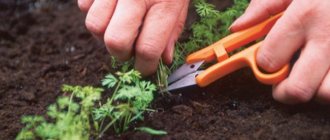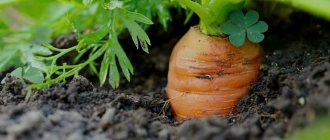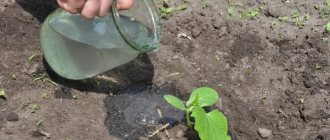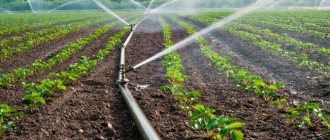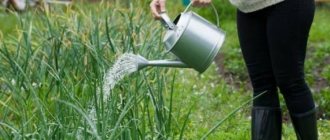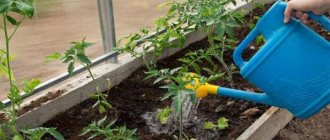Watering is the most important element of care when growing any vegetable crop in open ground. But different crops have different preferences in the frequency and volume of moisture application, so to obtain tasty and strong vegetables you need to adhere to certain rules. This material will talk about when and how to properly water carrots.
Norms for watering carrots in open ground
The main requirements for watering carrots, thanks to which you can expect an excellent harvest:
- The vegetable is most susceptible to moisture conditions during the period from the beginning of the sowing campaign to the formation of root crops.
- 400-500 millimeters is the level of natural precipitation that allows you to optimally obtain good harvest results.
- The carrot root crop needs from 40 to 44 cubic meters of moisture per hundred square meters (during the sprinkling method - approximately 50 cubic meters).
- The months with the most abundant water consumption are the period of root formation.
- Changes in moisture input cause growth spurts, which can lead to the appearance of cracks over the entire surface of the fruit.
Irrigation equipment
For high-quality watering, as well as to prevent leaching of seed material, use:
- Watering cans. To water carrots, a watering can is used, which has a thin and long pipe, as well as a removable divider with small holes.
- Hose. For large crop areas, you can use a durable, kink-resistant, flexible hose with a sprinkler attachment.
Watering with buckets is undesirable, since a strong stream of water will damage young plants, and the watering will be uneven, a crust will form in places, the soil temperature will drop sharply, which, in turn, will delay the germination of seedlings and wash out a large number of seeds.
Irrigation of the soil before sowing carrots in open ground
Whether watering is needed before sowing will depend on the timing of planting.
Soil moisture is most carefully controlled at the time of sowing: seeds from dried soil will take longer to grow and will fall off unevenly. If the soil is completely dry, then the seeds may not hatch at all. Dried soil should be watered very generously ahead of planting using a garden tube and a rain nozzle. You don’t have to worry about additional watering after a snowy winter (the ground is then moistened with melted snow).
Is it necessary to water the soil when sowing carrots?
The degree of soil moisture during planting determines the fate of the further growth of the root crop. Seeds require a lot of moisture in order to swell and germinate .
If the soil is too dry, the seeds may not germinate at all or may germinate unevenly.
Carrots can be planted in two ways:
- immediately into a moistened and loose soil mixture;
- Water it immediately after planting the seeds.
In the second case, you should not flood the soil with strong water pressure - it can wash away the seedlings, which will adversely affect the harvest. Also, strong water pressure can drive the seeds too deep into the soil, causing them to germinate later than required.
If the soil is insufficiently moist, the carrot core and skin become coarser . As a result, the vegetable acquires a more bitter taste and becomes lethargic.
On our portal there are articles not only about watering, but also about weeding carrots with kerosene.
Watering carrots after sowing
After sowing, the crop is irrigated only if the soil was not moistened before planting.
It is also impossible to water during the early planting period, since the seeds are washed out under the pressure of water. Here it is preferable to irrigate before sowing.
How to water carrots - video
If the soil was not watered before sowing, correct the situation using a finely nozzle watering can.
To avoid disturbing the row, it is better to use a spray jet, because the depth of sowing carrots is no more than one and a half centimeters.
In case of insufficient natural humidity (especially in summer or autumn), to stimulate the emergence of sprouts, a one-time watering is done during sprinkling (3-4 cubic meters per hundred square meters); during drip irrigation, several waterings of 200-300 liters per hundred square meters are carried out.
Subsequently, these procedures are carried out based on the weather, soil moisture, and the condition of the plant. In the second half of the growing season, the normal value for sprinkling will be from 4 to 5 cubic meters per hundred square meters.
Good varieties of vegetables:
Potato variety Granada Zucchini squash Black beauty Late-ripening cabbage variety Prestige
Subtleties of watering
How to water carrots in open ground:
- Preferably at the root, since wetting the leaves leads to the development of fungal diseases.
- Watering in the early morning or evening is recommended in hot and dry weather.
- In cool weather, the plant is watered in the morning, sometimes closer to the middle of the day. Evening watering is not recommended due to the high risk of fungal infection.
- Do not water plants with small amounts of water. The roots must be moistened, otherwise the water will evaporate from the soil surface.
- Seedlings, like seed material, need a moist top layer of soil. Plants that are rooted require moisture in the middle layers of the soil to develop and strengthen the root system.
- Mulching will be a good help to reduce evaporation from the soil surface. Adding compost to the soil will increase its ability to retain moisture.
- Loosening after watering is a mandatory procedure. The earthen crust inhibits the development and growth of the plant. The root system should not protrude above the surface of the earth.
- Hard water is first softened and then watered.
- Excessive moisture erodes the soil and increases its acidity. The root system begins to rot due to loss of oxygen and loses its ability to deliver nutrients and water to the above-ground part of the plant. To drain excess water, you can make the grooves deeper or dig grooves nearby.
How to properly water carrot seedlings
After the carrots sprout, the crop should be watered according to the following scheme:
The period when seedlings appear should be provided with the most abundant watering
. This should be done until the stems form (3-4 pieces on each plant). Vegetables that have already begun to ripen and become plump should be watered less frequently. Heavy soil requires more moisture.
The greatest attention to irrigation must be shown in the third stage of root crop formation. If moisture is uneven, this promises the formation of soil erosion.
Errors in watering
With insufficient watering, side shoots grow and the shape of the root crop changes. Carrots begin to grow in width due to lack of nutrients. Abundant moisture promotes the development of fungal infections. Excessive watering in combination with fertilizing is doubly dangerous. If the plant is not watered for a long time and then moistened abundantly, the root crop may crack and lose its beneficial properties. Thus, if you follow the rules for watering carrots, you are guaranteed a bountiful harvest.
Watering carrots during fruit formation
It is during this period that the carrot crop needs regular watering, the frequency of which will directly depend on the previous humidity. If before the formation of a root crop culture the amount of watering was sufficient, then over time the frequency of soil moisture must be reduced. Depending on the growth of the plant, the average frequency of watering carrots is once every 3-7 days, in a volume of 15-20 liters per 1 sq. m of soil. Moisture should penetrate 10-15 cm deep into the bed, but without stagnating.
At the stage of root crop formation, it is better to water carrots less often, but more abundantly.
A deficiency of water contributes to the formation of unpleasant-tasting, hard and small fruits, and too much water leads to the formation of lateral branches and the possible death of the main root. When the days are sunny enough, it is preferable to moisten the beds in the evening or early morning.
Rules for watering carrots and caring for root crops - video
Because watering in the sun leads to immediate evaporation of moisture from the soil, and even burns to vegetables that have overheated. Also, to create breathability after watering, it is better to loosen the soil.
Common mistakes when watering and their consequences
It is necessary to moisten the soil at all stages of development of roots and seeds, but this must be done in accordance with the rules, otherwise the yield level can be reduced.
What mistakes do gardeners make when watering carrots, and what are the consequences:
- If the crop is in dry soil, the fruits will be rough and their core will be too light. In addition, the taste changes - carrots become bitter. If the humidity level, on the contrary, is exceeded, then the fruits stop growing, as the above-ground foliage develops intensively. The plant is also subject to rot, mold and other diseases, and the root crop takes on a gnarled shape. To avoid these 2 mistakes, always water your plants evenly, at the same intervals. The amount of water depends on the stage of development of the vegetable.
- Not many people think about what kind of water to fill the carrot crop with. But this factor plays an important role. As already mentioned, cold water should not be used as it kills the root part of the plant. It is forbidden to water from a water supply, as such water often contains chlorine and other impurities. Therefore, water is first poured into containers and left to settle (24-48 hours is enough). But the best option is natural rain liquid, which can be collected during rainstorms.
- Another mistake novice vegetable growers make is raised beds. Yes, this technique has the right to life, but not in the case of carrots. The reason for this lies in the fact that the vegetable does not receive enough oxygen, and the moisture is not retained (it quickly goes into the lower layers of the soil). But there is an exception - carrots can be planted at a height where groundwater is close and in wetlands.
Watering adult carrots - before harvesting
For mature vegetables, irrigation should be reduced to a minimum. Excess humidity can have a negative effect on them. It affects the taste properties and appearance (lateral shoots may form).
Also, you should not allow the soil to dry out during this period; carrot fruits may harden and crack.
A ripe root crop is very sensitive to incoming moisture; therefore, watering must be done at a certain interval.
A month before harvesting, irrigation must be completely eliminated. When it comes time to harvest, the soil around the fruit needs to be moistened for easy removal.
And the weather in autumn is usually more saturated with precipitation without artificial irrigation.
The best varieties of carrots - video
Watering after thinning
On the 12th and 22nd days after germination, it is time to thin out the carrots. The procedure should be carried out carefully so as not to damage neighboring root crops. Immediately after removing unnecessary carrots, the beds should be watered generously. Experienced gardeners usually combine thinning with loosening and watering. This way, you can carry out all the necessary procedures in one evening and then not bother yourself again, but carry out loosening as the carrots grow.
If you do not remove excess sprouts in time, you may be disappointed when harvesting. The carrots will be small, twisted and rather limp. The taste will not be up to par. Strictly follow the recommendations provided and at the end of summer you will dig up first-class vegetables, much better than store-bought ones.
Temperature conditions and volumes of water for watering carrots
Many people make the mistake of using water from a well to irrigate carrots. Even taking into account that it is a hot period, the water they contain is very cold, and noticeable temperature changes are very bad for carrots, increasing the risk of their diseases.
Watering carrots should be done with water at a temperature corresponding to the air.
. To do this, you should collect water in a container in advance to warm it up in the sun, and only then use it for irrigation.
It's no secret that juicy carrots cannot be grown on dry soil poor in minerals. Carrots grow unsweetened, and sometimes with a bitterness, which manifests itself during a month and a half of storage.
Advice!
To sweeten root vegetables, carrots should be watered with a weak solution of table salt. This increases the carotene content in it, which is not only a valuable and useful substance, but also significantly improves the taste of carrots.
The effect of watering with salt will be clearly visible if it is carried out correctly and all necessary precautions and proportions are observed. Although nowadays there are many modern alternatives, this method justifies its existence. Especially when the crop is grown for a family with small children, and the absence of chemicals is fundamentally important.
Consequences of improper watering
Growing a decent crop of carrots is not an easy task. There are a lot of tips for care and watering. But many novice gardeners ignore existing rules. This approach can lead to sad results of summer work in the garden. To avoid such an unpleasant scenario, it is better to familiarize yourself with the standard mistakes when irrigating carrots.
The most common mistakes when watering:
- Excess moisture - if you overdo it and fill the beds with an excessive amount of water, the carrots will turn out unsweetened, with a minimum of nutrients. Such a vegetable will become fodder, that is, unsuitable for human consumption. The taste of the root vegetable will leave much to be desired; the carrots will be tough and rough. A large amount of moisture is also fertile ground for the development of fungi and diseases on root crops;
- Rare watering - if you go to the other extreme and water the beds too rarely, the carrots can grow intensely yellow. Among the consequences, one can note the expansion of roots and disruption of the shape of the root crop. The grown vegetable will not be sweet and juicy;
- Watering after a long absence of water - if you disrupt the regularity of irrigation procedures and then abruptly water the beds, the root crops will most likely become covered with cracks;
- Frequent watering, but with a small amount of water - the result of such actions will be limp and small carrots. But at the same time, the weeds will grow at twice the speed so that the beds will need to be weeded many times more often.
The best way to water is to regularly irrigate the bed, according to a strict schedule, but keeping an eye on the weather. You should check the need for watering using a shovel or your fingers, and if necessary, make changes to the irrigation schedule. Beginner gardeners can be advised not to deviate from the rules developed over the years, but at the same time do not be afraid to make corrections, depending on the weather and soil type. In this way you can get an excellent harvest of vegetables.
Dacha farming
0
Tweet
How does hilling carrots relate to soil moisture?
During the growing process, the upper parts of the carrot fruit become bare and come out on top of the soil. This is how solanine is formed. It will add bitterness to the fruit, so you need to hill it up to the line of carrot tops. The best time for this: in cloudy weather, or in the evening.
First, the soil is watered to facilitate the process of loosening it, so as not to disturb the plant roots with clods of dry soil during hilling.
Good variety!
Carrot Autumn King Carrot Flakke
Carrot feeding
In addition to watering, carrots also need liquid feeding. When grown on well-fertilized soils, you can feed the plants with solutions of EM preparations (Baikal EM1, Vostok, Siyanie), this works especially well on mulched beds.
To feed carrots, you can use modern biofertilizers rather than chemicals
If compost or humus was not added to the soil before planting, then during the summer period you need to feed the carrots at least 3 times.
- The first feeding is carried out 1 month after planting. Dilute 1 tablespoon of nitrophoska per 10 liters of water (per 1 square meter) and water the carrot bed on the damp soil.
Carrots are fed 2 times with Nitrophoska, adding a solution with watering
- The second feeding is carried out 2-3 weeks after the first; 1 tablespoon of nitrophoska per 1 square meter is also used. meter of bed.
- The third feeding is given in August. It is best to use an ash solution for this: 1 glass of ash is poured with a liter of boiling water and left for several hours. Then bring this volume to 10 liters and water the carrots.
Proper combination of watering carrots with feeding root crops
A rich harvest without additional feeding can only be achieved on soil that is well fertilized in the fall. However, the best solution would be to additionally fertilize carrots in open ground 2-3 times during all stages of cultivation.
Complementary foods are applied in liquid form, so it would be logical to fertilize carrots together with watering the beds with the planted crop:
- When the first shoots appear (after the first month after planting carrots), fertilize with the following mixture: dissolve 20-25 grams of mineral nitrogen-containing fertilizers, 30 grams of mineral phosphorus fertilizer and 20 grams of potassium salt of hydrochloric acid in 10 liters of water.
- The next fertilizer is carried out one and a half months from the previous one. It is more convenient to combine it with the second thinning. Then the fruit will absorb a nutrient cocktail of superphosphate and potassium chloride. As for their ratio, this is 30 grams of the element per bucket of water.
- At the end of July, it is necessary to feed the fetus with a potassium solution (10 liters of water, 30 mg). This is the third stage. Potassium ensures an increase in sugar content and rapid ripening of the fruit.
- In the second half of the growing season, you can use an infusion of ash as a potassium supplement.
- In addition, you can feed the fetus up to two times with a B(OH)3 solution (1 teaspoon in a bucket of water). The consumption of nutrients in this case should be 9-11 liters per 1 sq.m. area. In order to avoid burns to the roots, irrigation must be carried out along grooves with a depth of 3 to 6 cm, located at a distance of 6 to 9 cm from the row with the root crop.
How often and when should you water carrots?
The crop is often planted in a sunny place where the soil dries out quickly, so it cannot do without watering, especially in hot summers. But in order for the plants to develop normally and form root crops typical for their variety, carrots must be watered according to certain rules during different periods of the growing season of this crop.
Before sowing
It has been established that carrot seeds need a lot of moisture to germinate, so the soil is moistened both before and after sowing. A couple of days before this event, the area where the carrots will grow is thoroughly watered to thoroughly wet the ground. Instead of plain water, you can use a pink solution of potassium permanganate: with its help you can not only water, but also disinfect the soil.
On the day of sowing carrot seeds, furrows are made in moist soil and the seeds are sown in them according to the planned pattern. Then the furrows are covered with earth and the beds are watered again. Before the shoots appear, the soil under the carrots must remain moist, otherwise the seeds, which are already not good at germination, will take a long time to germinate, or even not germinate at all, so the beds are covered with film to create a greenhouse effect, which promotes the speedy germination of seeds. From time to time, the film is removed to water the plants again and ventilate the soil. It is left until the carrot sprouts break through to the surface. After this, the film is removed.
After sowing
Young, newly emerged plants are watered 2-3 times a week, and if the weather is hot, then even more often. For every sq. m, manually pour out at least 4-5 liters of water, install sprinklers on the beds or lay drip irrigation hoses. There is no need to over-water carrot seedlings; they may become infected with Alternaria (blackleg) and as a result, some of them will die.
For watering, it is best to use a watering can with a long pipe and a medium-sized fine-mesh nozzle, preferably removable so that you can clean it or change it if necessary. The advantages of this method of watering are as follows: using a watering can, you can spray water evenly over the entire surface of the beds, preventing the seeds from being washed out and bunched up. And if cool water is used, prevent a sharp drop in soil temperature during watering. For large areas planted with carrots, you can use a garden hose with a sprinkler at the end. It is not recommended to water plants, especially young ones, with buckets: the water pressure is too strong, and it spreads unevenly, as a result the soil is also soaked unevenly. As a result, in certain areas of the beds the plants will be waterlogged, while in others they will suffer from a lack of moisture.
During the growth period of young plants
When the carrots begin to grow, water them less often and in small portions of water - as the top layer of soil in the beds dries, about 1-2 times a week.
After each watering, the soil is carefully loosened to fluff it up. Carrots should also be watered after thinning the seedlings and young plants. This must be done so that the carrots that remain in the beds can grow after possible damage to the roots. What time of day is best to water carrots after planting? Like other crops, it is best to irrigate it in the evening or early in the morning so that the water does not evaporate quickly and the plants use it to the maximum during the night hours. For this reason, you should not water carrots during the day, especially in hot weather. But, if there is no other way out, and you have to water the vegetables during the day, then you need to do it very carefully so that the water does not get on the plants themselves.
This culture is also not indifferent to water temperature. It should be comfortable - a little cool in hot weather, warm when cloudy. You can’t water carrots with completely cold water: this causes their roots to experience temperature stress, which negatively affects the plants themselves, and the roots can partially die or become affected by root rot. To avoid this, before watering, water should be accumulated in some large container exposed to the sun: for example, a barrel or an old bathtub. In it, the liquid will gradually heat up and will be suitable for watering. From there it can be collected into a watering can or pumped up with a pump. After each watering, the soil must be loosened so that a crust does not appear on it, and air can easily penetrate to the roots of the carrots.
In general, how often you need to water carrots depends on the climatic features of the area, the type of soil on the site, how close the groundwater is and other factors. Therefore, only approximate norms for watering carrots are given here; they can be adjusted depending on the circumstances.
In the phase of root crop formation
During this growing season, carrots need to be watered even less frequently, but the volume of water must be increased. Plant watering scheme: pour on each square approximately once every 1-1.5 weeks. m, 2 buckets of water or more to wet the soil in carrot beds to a depth of 10-15 cm, no less. After each regular watering, loosen the soil, as when caring for young plants.
Formed plants
The main condition for watering carrots in open ground during this period of their growing season is that it should be uniform, but moderate.
The consequences of improper watering are as follows: if there is not enough water, the carrot roots will begin to deform, branch, become crooked and ugly. Due to lack of moisture, some of them may throw out the peduncle. Such root vegetables will no longer be of any use. Therefore, for every sq. m of carrot beds, pour out as much water as it takes to thoroughly wet all the soil (about 2 buckets for this area). At the same time, excess moisture is harmful for root vegetables: this can cause them to become overgrown with additional roots, which will worsen their appearance, and they will also become fragile and not tasty. They can also get sick: in waterlogged soil, rot pathogens activate much faster, and root crops can begin to rot right in the beds. The combination of waterlogged soil and a lack of nutrients in it is especially dangerous.
It is also important to observe the regularity of spills of already formed carrots. This is very important: if there are long breaks in watering, it will not be possible to grow good root crops. Rare and abundant watering is especially dangerous for this crop: after it, already sufficiently formed root crops crack, which significantly reduces the quality of the crop. The situation with frequent watering with a small amount of water is also unacceptable: in this case, the carrots will not have enough moisture and they will be dry, hard, woody and not tasty.
You should stop watering carrot root crops that you plan to store for storage 2-3 weeks before harvesting so that they are not too wet and then rot in storage. However, you can water them a few days before harvesting if the soil is too dry: solely to make the root crops easier to pull out of the ground. If, after digging, they turn out to be too wet, they must be dried in the beds or in a dry room, and only then sent for storage.
We recommend reading
Features of storing carrots in the cellar and at home
Rules for planting carrots in spring in open ground with seeds
When and how to thin carrots correctly
The best way to feed carrots and how to apply fertilizers correctly
If the soil is mulched
Mulching can eliminate weeds near growing crops, improve the reproduction of microorganisms in the soil, in addition, it preserves soil moisture and reduces temperature changes
. And since a crust does not form on the surface, periodic loosening as such is not required. It is capable of maintaining double the amount of moisture in the garden bed. The longest possible maintenance of moisture is facilitated by abundant watering of the soil and covering it with grass mulch. This promotes longer retention of moisture, saves not only water consumption, but also energy, and reduces the number of soil irrigation cycles.
Mulching, loosening and weeding after watering
When growing carrots, it is extremely useful to perform mulching, weeding, and loosening the soil as care.
Mulching after watering is very useful, as it retains moisture in the soil for a long time, so you can water the plant less often. It can also prevent carrot flies from laying eggs in the garden bed. Rotted sawdust, peat, and straw can be used as mulch for row spacing. The thickness of the mulch layer is about 5 centimeters.
If you do not mulch the carrot bed, then after adding moisture it is highly recommended to loosen the soil between the rows, simultaneously weeding the weeds . Loosening and weeding should be done after the water is completely absorbed into the soil (after about 2 hours). The depth of loosening is three to five centimeters.
If the carrots did not have enough watering or there was too much moisture
Irregular and low soil moisture provoke yellowing of carrots and their deformation. In attempts to find water, it grows sideways with shoots, which makes it inconvenient to use in the future.
Very frequent watering of carrots after planting provokes the development of various diseases, such as fungal ones. The combination of an excess of moisture and its lack leads to improper development of the root crop, the fruits grow small and will not be stored well.
It is also a mistake to grow carrots in high beds. Because even with the most generous watering, the vegetable will experience a lack of moisture.
Provided that you follow the watering rules without making mistakes, you will harvest an excellent quality harvest suitable for long-term storage.
Should I water carrots in September?
In August, the carrots were already fully formed and reached their maximum possible size.
This month it is very important to water correctly, since the success of long-term storage of the grown crop largely depends on this.
Experienced gardeners try to water carrots no more than twice in September, and then only when abnormal heat sets in. Excessive accumulation of moisture in the root crop can cause it to rot during storage of the harvested crop.
A situation may also arise when root crops that are almost ready for harvest begin to crack, thereby reducing their marketable value.
Therefore, it is very important that during this month, excess moisture leaves the root crop through evaporation from the surface of the leaves. Check out other tips on how to properly remove carrots from the garden.
How to care for carrots after planting?
sveta125 over a year ago
How often to water, is there anything else you can recommend to increase the yield?
Shooik over a year ago
Carrots do not require special care after planting; I weed and thin them at the very beginning so that the carrots are large, and then I remove only large weeds. Before planting carrots, I plant mustard in the garden bed and dig it up, leaving the mustard in the ground. This helps to escape from the wireworm so that it does not spoil the harvest.
the author of the question chose this answer as the bestcommentlady v 1 week ago
The main concern of the gardener after planting carrots is watering and weeding them. There is no need to do anything particularly complicated to increase productivity. When the carrots grow 3-5 centimeters, they should be weeded from weeds, since during this period they have time to grow.
It is better to weed in damp soil so as not to leave broken weed roots in it. When the carrots grow another 5 centimeters, they can be thinned out, because the carrot seeds are small and it is very difficult to distribute them evenly.
Therefore, if there are accumulations of carrots in the garden bed, then we pull out the excess sprouts mercilessly, otherwise they will simply crush each other. Of course, about 10-15 centimeters between root crops is too much, 2-3 is enough, especially since as they grow, you will pull out carrots for food and finally thin out the plantings. Well, watering once a day is necessary, quite strong, especially in a dry year.
What determines the frequency of watering?
Water consumption and frequency of procedures depend on many factors: the phase of carrot development, weather conditions and even the variety.
Thus, during the period of root crop formation, the need for irrigation is high, but as it ripens, their frequency is reduced to a minimum, and a few weeks before harvest, irrigation stops completely.
Naturally, during drought, carrots, like any plant, will need additional irrigation, and in rainy weather this procedure will need to be postponed. And one more thing: varieties such as Golandka, Tushon, Tip Top, Losinoostrovskaya love abundant watering, but Perfectsiya and Sirkana F1 are quite resistant to drought.
With frequent and excessive moisture, the plant begins to intensively develop its above-ground part - the tops, and the root crops stop their growth: a large number of lateral shoots are formed on them, and the main root gradually dies off.
If there is a lack of moisture, carrots grow small in size, with a rough, hard core, tough skin and a bitter taste.
Help If, after a long absence of watering, the carrots are immediately moistened abundantly, the root crop will crack (the risk especially increases in the second half of August), which threatens the loss of presentation, taste and the constant threat of infection by infectious diseases. This phenomenon is explained by the fact that the growth period (moisture) and the rest period (lack of moisture) alternate abruptly, and not as it should be. To prevent this from happening, the required level of humidity should be restored gradually, and it is better to avoid such a situation altogether.
Secrets of proper watering from experienced gardeners
It happens that even planting done according to all the rules and most carefully followed care recommendations do not save you from disappointment at the time of harvest. Vegetables come to the surface pale, gnarled and branched into many unnecessary shoots. What is the matter and is it worth stopping your gardening experiments here?
This result is, as a rule, the error of improper soil moisture, or rather, weak penetration of moisture to the entire required depth of root crop formation. The roots, which determine the level of moisture, are thin white hairs that sensitively detect any changes in the saturation of the soil with water.
Starting to dry out, they stop growing downwards and begin to look for options in which they can get water in other directions. This is where we get strange rhizomes with outstretched arms and legs, unsuitable for cooking.
Correction of the error is possible no later than a month before digging up the crop. Between the rows you should dig grooves 10-12 cm deep, then the garden needs to be watered, but the emphasis should be on filling these grooves to the top - this will make it easier for moisture to penetrate to the required depth.
Make it a habit to collect rainwater and use it for irrigation. If only tap water is available, it must be left in a container for at least three days. One day is enough for well water, but only if during this time it has time to warm up well to 18-21.
Moisture requirements of carrots
To form smooth, large and juicy root crops, carrots need watering throughout the entire growing season - from the moment the seeds are planted in the ground until the harvest is dug up. For this crop, it is important to maintain approximately the same soil moisture, although at different stages of development this need may increase or decrease:
- in overdried soil, fruits grow sluggishly, acquire a rough texture, and sometimes a bitter taste;
- excessive watering of carrots leads to slower growth, distortion of the shape and the outflow of most useful substances into the tops;
- sharp changes from drought to abundant humidity provoke cracking of root crops.
Uniformity in watering helps to adhere to the “golden mean” - they are carried out at equal intervals , but their length and water consumption rates vary depending on the periods of crop development.
The data below is calculated for carrot varieties with an average ripening period and weather without sufficient rainfall:
- in May, it is recommended to carry out 6-8 irrigations with a water flow rate of 5-6 l/sq.m. m;
- in June - 4-6 waterings, spending 10-12 liters of water per square meter;
- in July, it is enough to water carrots once a week at the rate of 12-15 liters per square meter;
- in August - 1-2 times, using the same volumes of water as in May.
With experience, the gardener comes to understand how much moisture a vegetable needs at different times. Thus, darkening, curling and lethargy of the tops are signs of depression of plants from drought and the need for several urgent waterings.
Pre-sowing watering
The timing of crop sowing largely depends on the state of natural soil moisture. Experienced gardeners determine the level of sufficient soil moisture by inserting a peg into it and lightly pressing it onto the walls of the resulting depression. If they hold on and do not crumble, the soil is sufficiently moistened.
If the soil is too dry, it is important to moisten the soil well before sowing the seeds, since when they are planted in dry soil, they can easily be washed out later by a stream of water. To do this, two days before planting, the beds are thoroughly watered using a sprinkling method using a hose with a special nozzle or a watering can.
Immediately before planting, the prepared furrows in the beds are watered again and compacted with the edge of the board so that the kernels are not “drawn in” too deeply. You can replace water with a saturated solution of potassium permanganate (5-10 g per liter of water).
The furrows with the planted seeds are sprinkled with a mixture of sand and peat, after which covering material is fixed to the bed to retain moisture and heat.
Post-sowing watering of seedlings
If there was no possibility of pre-sowing soil moisture, immediately after planting the seeds, you need to carefully water the rows from a watering can - little by little, repeating the procedure for several days in a row. You should not do this with a hose: strong jets of water will at least mix the light layers of dry soil, the seed kernels will end up at different depths and will not sprout uniformly in even rows.
